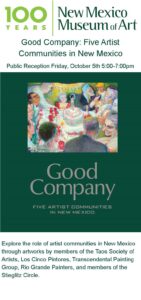Good Company: Five Artist Communities in New Mexico
New Mexico has consistently provided fertile ground for communities of artists to gather together and create shared forums for their individual visions. The Taos Society of Artists, Los Cinco Pintores, the Transcendental Painting Group, Rio Grande Painters Group and the artists of Stieglitz circle were among the many communities of artists that formed in New Mexico over the first half of the twentieth century. Despite their shared desire to build a creative community each of these five groups had a distinctive aesthetic, artistic philosophy and reasons for joining together. It is important to keep in mind that common artistic interests of individual members, not a didactic “school” mindset, informed the aesthetics of these groups. Viewed together these artists offer a fair overview of the art scene that thrived here during the first half of the twentieth century. Their works express the variety and range of creative output in New Mexico during this pivotal time in American and Southwestern art history.
 At the end of the nineteenth century some of the first academically-trained American artists began to visit Taos, later to form the Taos Society of Artists. After the Taos Society disbanded in 1927, Taos remained a thriving arts center with major American Modernists passing through to experience the Southwest for themselves. Many of these artists were already active in the New York art scene based around the gallery of visionary photographer Alfred Stieglitz. These same artists were drawn West to the salon of patron Mabel Dodge Lujan, who was also connected with Stieglitz and whose early embrace of Modernism provided early support for many of twentieth-century America’s most innovative figures. Taos was also the birthplace of the Transcendental Painting Group, but the group was not tied to Taos, with members active in Santa Fe, Albuquerque and Cathedral City, California among other places. In 1917 the New Mexico Museum of Art opened, signaling New Mexico as a destination that valued and supported the arts, and thus drew numerous artists from across the country to live and work here. Santa Fe then began to cultivate an artistic identity distinct from Taos, and the artists working here formed their own groups, including Los Cinco Pintores in the 1920s and the Rio Grande Painters Group a generation later. Most of these groups were formally active for only a short period of time. The artists in this exhibition were already creating significant works before joining their respective communities and these works of art reflect that wide scope of work. Once the formal community system was no longer useful, the creative vision of the artists involved did not die out.
At the end of the nineteenth century some of the first academically-trained American artists began to visit Taos, later to form the Taos Society of Artists. After the Taos Society disbanded in 1927, Taos remained a thriving arts center with major American Modernists passing through to experience the Southwest for themselves. Many of these artists were already active in the New York art scene based around the gallery of visionary photographer Alfred Stieglitz. These same artists were drawn West to the salon of patron Mabel Dodge Lujan, who was also connected with Stieglitz and whose early embrace of Modernism provided early support for many of twentieth-century America’s most innovative figures. Taos was also the birthplace of the Transcendental Painting Group, but the group was not tied to Taos, with members active in Santa Fe, Albuquerque and Cathedral City, California among other places. In 1917 the New Mexico Museum of Art opened, signaling New Mexico as a destination that valued and supported the arts, and thus drew numerous artists from across the country to live and work here. Santa Fe then began to cultivate an artistic identity distinct from Taos, and the artists working here formed their own groups, including Los Cinco Pintores in the 1920s and the Rio Grande Painters Group a generation later. Most of these groups were formally active for only a short period of time. The artists in this exhibition were already creating significant works before joining their respective communities and these works of art reflect that wide scope of work. Once the formal community system was no longer useful, the creative vision of the artists involved did not die out.
Juxtaposing these five groups offers a close comparison of the characteristic ways each group engaged the unique culture and landscape that drew them to New Mexico.
click here to view the exhibiton checklist
Installation Images
To view more artworks from this exhibition visit our online collections here